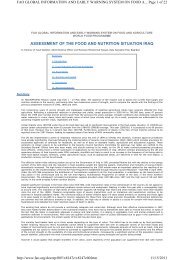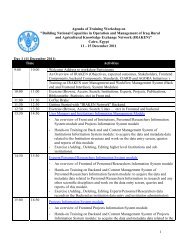Vermiculture in Egypt: - FAO - Regional Office for the Near East and
Vermiculture in Egypt: - FAO - Regional Office for the Near East and
Vermiculture in Egypt: - FAO - Regional Office for the Near East and
Create successful ePaper yourself
Turn your PDF publications into a flip-book with our unique Google optimized e-Paper software.
which needs to f<strong>in</strong>d o<strong>the</strong>r alternatives such as, organic agriculture that could be one of<br />
<strong>the</strong> important options that have a good opportunity <strong>in</strong> a wide zone of <strong>the</strong> newly<br />
reclaimed l<strong>and</strong>s <strong>in</strong> <strong>Egypt</strong>. Moreover, recycl<strong>in</strong>g of farm waste <strong>and</strong> compost<strong>in</strong>g is<br />
ano<strong>the</strong>r alternative <strong>for</strong> renew<strong>in</strong>g soil fertility that has very low organic content<br />
(Table.5.1). Harvest<strong>in</strong>g <strong>the</strong> fruits or gra<strong>in</strong>s, which is a small proportion of a whole<br />
plant system, <strong>and</strong> return<strong>in</strong>g <strong>the</strong> rema<strong>in</strong><strong>in</strong>g plant residues after compost<strong>in</strong>g back to <strong>the</strong><br />
soil will result <strong>in</strong> a m<strong>in</strong>imum need <strong>for</strong> additional m<strong>in</strong>erals. Substitut<strong>in</strong>g any quantity<br />
of chemical fertilizers will result <strong>in</strong> a cleaner production <strong>and</strong> environment, as well as<br />
less emissions of greenhouse gases, <strong>and</strong> consequently <strong>the</strong> organic farm<strong>in</strong>g growers<br />
can get substituted through <strong>the</strong> clean development mechanism (CDM) of Kyoto<br />
protocol, which will be discussed <strong>in</strong> more details <strong>in</strong> a separate chapter later.<br />
Table 5.1. Physical <strong>and</strong> chemical analysis of various soil types.<br />
Item<br />
North<br />
Delta<br />
South<br />
Delta<br />
46<br />
Middle &<br />
Upper<br />
<strong>Egypt</strong><br />
<strong>East</strong> Delta West Delta<br />
Soil texture Clayey Clayey Loamy clay S<strong>and</strong>y Calcareous<br />
pH (1:2.5) 7.9-8.5 7.8-8.2 7.7-8.0 7.6-7.9 7.7-8.1<br />
Percent total soluble salts 0.2-0.5 0.2-0.4 0.1-0.5 0.1-0.6 0.2-0.6<br />
Percent calcium carbonate 2.6-4.4 2.0-3.1 2.6-5.3 1.0-5.1 11.0-30.0<br />
Percent organic matter 1.9-2.6 1.8-2.8 1.5-2.7 0.35-0.8 0.7-1.5<br />
Total soluble N (ppm) 25-50 30-60 15-40 10 – 20 10 -30<br />
ppm available P (Olsen) 5.4 -10 3.5-15.0 2.5-16 2-5.0 1.5-10.5<br />
ppm available K (ammonium<br />
acetate)<br />
250-500 300-550 280-700 105-350 100-300<br />
Available Zn (DTPA) (ppm) 0.5-4.0 0.6-6.0 0.5-3.9 0.6-1.2 0.5-1.2<br />
Available Fe (DTPA) (ppm) 20.8-63.4 19.0-27.4 12.4-40.8 6.7-16.4 12 - 18<br />
Available Mn (DTPA) (ppm) 13.1-45 11.2-37.2 8.2-51.6 3-16.7 10 - 20<br />
Source: <strong>FAO</strong> (2005).<br />
5.2. Fertilizer statistics<br />
The dem<strong>and</strong> <strong>for</strong> food <strong>and</strong> o<strong>the</strong>r agricultural commodities is <strong>in</strong>creas<strong>in</strong>g <strong>in</strong> <strong>Egypt</strong> due to<br />
<strong>the</strong> <strong>in</strong>crease <strong>in</strong> <strong>the</strong> population <strong>and</strong> improvements <strong>in</strong> liv<strong>in</strong>g st<strong>and</strong>ards. Ef<strong>for</strong>ts cont<strong>in</strong>ue<br />
to improve crop productivity <strong>and</strong> quality. Appropriate fertilization is one of <strong>the</strong> most<br />
important agricultural practices <strong>for</strong> achiev<strong>in</strong>g <strong>the</strong> agricultural improvement (<strong>FAO</strong>,<br />
2005).<br />
The ma<strong>in</strong> commercial types of fertilizers used <strong>in</strong> <strong>Egypt</strong> <strong>and</strong> <strong>the</strong> percentage of active<br />
<strong>in</strong>gredients are listed <strong>in</strong> Table 5.2.





